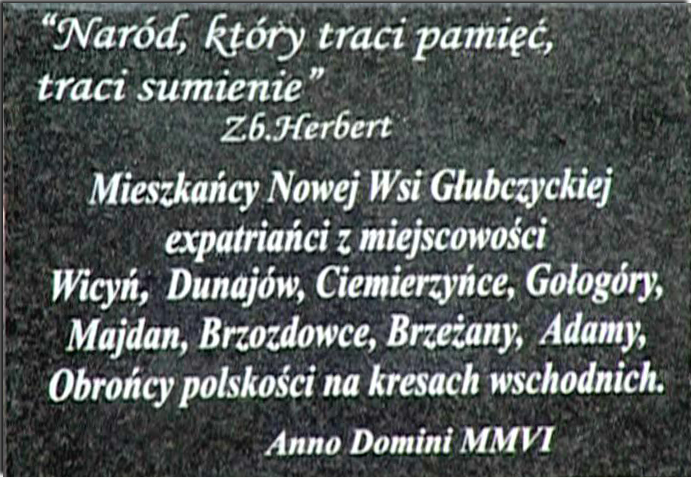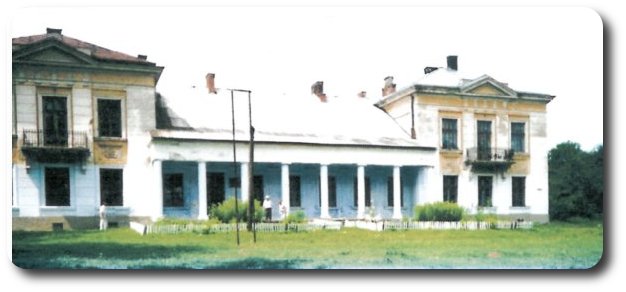TheEasternBorderlands
- Wojciech Goniowski
- in Menu głowne
BORDERLAND ROOTS
The current residents of the Nowa Wieś Głubczycka for Głubczycka have their roots on Eastern Lines. From them an ancient town is a cradle of the majority WICYŃ on Podolu (district Złoczów, Tarnopol province)
She was it is an exceptional village, about origins reaching times of Piast Poland, one from few on Lines with the population (c 1800 residents) almost entirely Polish.
Village which is the subject of the research of historians, which books, studies, memories are written about. Village which outstanding individuals left, in order to recall such priests as Rev. Józef Embolism- Przytocki (1912-1978) Lt. Col. of the Home Army, or the Rev. infułat Bronisław Gwóźdź. (1922-2005)
In the time of war structures in Wicyniu well organised of the Home Army acted (Institution "Wolf", Inspectorate Złoczów, Tarnopol Circuit, Area nr3 of Leoes). The village was transformed into a real stronghold of the self-defence and a place of sheltering Poles during genocidal ethnic slaughters being mad on these areas. In this respect Wicynia self-defence, which in critical years 1943-45 he consisted of c 2000 people along with fugitives from surroundings, is a phenomenon of the resistance movement on Lines.
Memory about Wicyniu - the one clear and the one tragic - stored here in hearts of the older generation he lives and is also accompanying younger.
A sentence of Zbigniew Herbert which residents put on the modest obelisk in the middle is reminding the village of her meaning: "The Nation which is losing its memory, is losing the conscience" (below)

Manor house in Wicyń
Within centuries name of the village Wicyń changed repeatedly. In the second half XIVw. she sounded Wieczin, in XVw. Wysczen or Wysuczen, in the XIX beginnings.
Wycin, before settled as Wicyń. She was it is at first a royal land, which in 1389r. along from nearby Władysław Jagiełło gave Mikołaj Ciemierzyncami from Gołogór for Gołogórski, putting the military duty on it. Daughter of his grandson (?), also Mikołaj, castellan halickiego- Katarzyna, getting married for Andrzej (of Jędrzej) from Hay of Sienieński (of Sieniński) h. Dębno, of Sandomierz chamberlain, for him probably contributed this property in her dowry. Into this way Wicyń entered with time to belonging to Sienieńskich fudge pomorzańskiego. In 1483r. they went to them in the end and ancestral Bare-mountain bare-mountained.
In 1604r. Bare-mountained Marek Sobieski bought (W1605r amendment.), grandfather of the king. Earlier, because he purchased in 1598r. Złoczów. c 1620r. Marek's son - Jakub Sobieski, bought also Pomorzany from Krzysztof Sienieński with 17 villages, as well as from Wicyniem. Jakub Sobieski populated Tartar villages ravaged by verbal assaults and developed anew, Wicyń whereas, "destroyed and cut out", filled with Mazurians. The Polish population weathered in this village almost to the end of the Second World War.
To fudge pomorzański belonged Wicyń probably all the way to the expiration of the Sobieskich family after the sword and the distaff. Later he went into the possession Radziwiłłów which sold the ancient Crown lands off. In 1788r. Stanisław Pruszyński bought Pomorzany, but how it seems, without Wicynia. So it isn't known who was a next owner of this wealth. Only in the first half the 19th century is acting as his heiress Olympia Matkowska. She, or also her heirs sold majatek in Wicyniu into Jewish hands. After 1890r. of the good those Mirosław Eder purchased (amendment in 1906r.). After his death the wealth passed Maria to the widow after him from the house Stanek (amendment in 1932) which for her two daughters, Maria and Bronisława inherited from.
To 1907 a modest built manor house existed in Wicyniu after Matkowskich or their predecessors, dating back perhaps from the XVIII end, but most confidently of beginnings the 19th century He was situated on the slope of the gentle hill, so had foundations from the side of the drive higher than from the garden. The front accentuated it prominent break with the columned portico and the small garret. Elevations were covered with smooth plaster. Big, rectangular, ośmiokwaterowe windows were located in profiled frames. The moulded also cornice encircled the house beneath eaves. Building that was covered with the quite high, smooth roof czterospadowym, beaten up with shingles, enthusiastic with little semicircular dormer windows on both sides of the break.
From 1907 an expansion of the old manor house began to the postclassical palace. A Veltze architect drew the project of the reconstruction up. On completion of work it remained from old substance little, because even a disintegration of window openings of the house was changed. Entirely anew also side wings were raised.
In the end of these all changes Wiciński had a palace still centre, old part of the ground floor, however raised about low pseudomezzanino, triaxial whereas side new parts two-tier. Central part a little bit towards new wings moved back on entire for her a half-deep portico preceded lengths, compound from eight in identical from oneself distances of Tuscan columns, on the stone terrace taken out against four steps, placed. They carried columns divided tryglifami entablature, closed off with malleolar cornice, and above still prominent profiled. The portico was covered with the roof jednospadowym about minute inclination. Closed elevation with frames of the alcove, was divided with flat pilasters single, while for her corners were underlined with pilasters put on oneself double, placed on pivots of extreme units. Predominant feature of side wings with vertical belts shared with elevations boni constituted balconies with a balustrade iron, planted on the console tables decorated with the plant relief. Panels window, put on either side of balcony console tables, mouldings filled up.

From the side garden, designed much more modestly than at the front, deprived pseudomezzaninu and of balconies, a surrounded terrace included the centre reverence of the palace with balustrade tralkową. A triangular, flattened bridgehead here crowning them taken hold into frames fastened three centre pivots together of moulded cornice. Both both main elevations, as well as dwuosiowe side, crowned also a moulded cornice. The building was covered with the roof above the centre quite high, gable corps, above side wings czterospadowym, beaten up with metal sheet.
Inside as representative served dwutraktowa centre reverence of the extended palace. In the middle of the front route a lobby was located, by the terrace whereas garden big and little dining room. A large room front, taking the half of the left wing was donated to the fair. Other rooms in both storeys were used as residential or economic. The decor of all rooms was modest. In the living room mouldings only decorated the ceiling. Parquet floors had no patterns. Stoves only in the living room and in both dining rooms were made from pressed tiles, in other - from smooth.
The park occupied the area of the about 5 ha. It included the house from every side. At the front a semicircular lawn stretched out, with the trimmed hedge, with numerous decorative bushes and flower flower beds. On it also two silvery spruces grew. In front of the palace, parallel to it, a road entry, leading from the village to economic buildings directed. On the right-hand side of palace a one-storey extended outbuilding, belonging to the previous manor house, demonstrating no stylish features stood. Large portion of the garden, closed also parallel to the palace with constructed hornbeam lane, stretched out apart from the house. A wide avenue, leading to the neo-Gothic chapel erected on the pivot of the house sepulchral, designed also by Veltza divided it into two rectangles. Most often being found in a park wicyńskim old ash trees and spruce timbers mixt with fruit trees were trees. However eight lime trees were the biggest ornament of the garden, remembering reputedly Sobieski`s times.
Roman Aftanazy "History of the residence on former lines of the Republic"
- Odsłony: 4785
